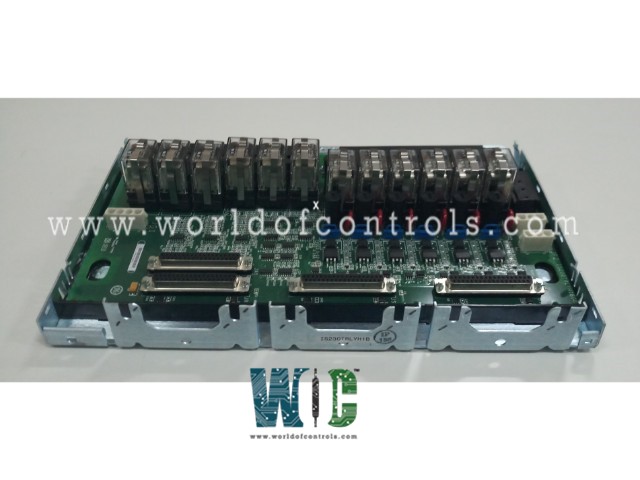
World Of Controls understands the criticality of your requirement and works towards reducing the lead time as much as possible.
IS230TRLYH1BA - Solid-State Relay Output Terminal Board is available in stock which ships the same day.
IS230TRLYH1BA - Solid-State Relay Output Terminal Board comes in UNUSED as well as REBUILT condition.
To avail our best deals for IS230TRLYH1BA - Solid-State Relay Output Terminal Board, contact us and we will get back to you within 24 hours.
SPECIFICATIONS:
Part Number: IS230TRLYH1BA
Manufacturer: General Electric
Series: Mark VIe
Product Type: Solid-State Relay Output Terminal Board
Number of channels: 12
Maximum operating voltage: 250 V rms
Maximum off-state leakage: 3mA rms
Power supply voltage: 28 V dc
Voltage Range: 14 to 32 V dc
Max response time on: 1ms
Mounting: DIN-rail mounting
Technology: Surface mount
Operating temperature: -30 to 65°C
Size: 17.8 cm wide x 33.02 cm
Repair: 3-7 Day
Availability: In Stock
Country of Origin: United States
Manual: GEH-6421M
FUNCTIONAL DESCRIPTION:
IS230TRLYH1BA is a Solid-State Relay Output Terminal Board manufactured and designed by General Electric as part of the Mark VIe Series used in GE Distributed Gas Turbine Control Systems. The TRLYH1B terminal board is a 12-output relay board equipped with solid-state relays for its outputs and includes isolated output voltage feedback on all 12 circuits. The use of solid-state relays enables the board to be certified for Class 1 Division 2 applications. This design necessitates three different board types.
Unlike the form-C contacts found on mechanical relay boards, all 12 outputs on the TRLYH1B are single, normally open (NO) contacts. The board does not provide user solenoid power distribution. In the Mark VIe system, the TRLYH1B works with the PDOA I/O pack and supports both simplex and TMR applications. The PDOA connects to the DC-37 pin connectors on the terminal board, with connector JA1 used for simplex systems and connectors JR1, JS1, and JT1 used for TMR systems.
INSTALLATION:
Wire the 12 solenoids directly to the I/O terminal block on the TRLYH1E terminal board as depicted in the TRLYH1E Terminal Board Wiring diagram. The terminal block is secured with two screws and features 24 terminals capable of accepting wires up to #12 AWG. Ensure correct polarity when connecting loads to the DC relays, which are unidirectional. Adjacent to each terminal block, there is a shield terminal strip connected to the chassis ground. Customers are responsible for externally powering the solenoids.
OPERATION:
The TRLYH1B board features solid-state relays, relay drivers, and output monitoring. Upon power-up, the relays remain de-energized until connected to any control source. Each relay output incorporates a failsafe mechanism that triggers de-energization if a cable is unplugged or communication with the associated I/O processor is lost. In simplex operation, control signals and relay output voltage feedback signals pass between the I/O processor and TRLYH1E via connector JA1. For TMR (Triple Modular Redundant) applications, relay control signals are distributed to TRLYH1E from the three I/O processors R, S, and T through connectors JR1, JS1, and JT1. These signals undergo voting, and the resultant signal controls the corresponding relay driver. Power for the relay drivers is supplied from all three I/O processors and is shared through diodes.
WOC has the largest stock of OEM replacement parts for GE-distributed control systems. We can also repair your faulty boards and supply unused and rebuilt boards backed up with a warranty. Our team of experts is available round the clock to support your OEM needs. Our team of experts at WOC is happy to assist you with any of your automation requirements. For pricing and availability on any parts and repairs, kindly contact our team by phone or email.
How do SSR output terminal boards work?
SSR output terminal boards typically have input terminals for the control signal (from a PLC or controller) and output terminals for the load (such as heaters, motors, or lights). When the control signal activates the SSR, it switches the load circuit on or off using solid-state components (usually semiconductor devices like thyristors).
Do SSR output terminal boards require external heat sinks?
The need for external heat sinks depends on the current rating and the design of the SSR used with the terminal board. High-current SSRs may require external heat sinks for proper heat dissipation, especially in applications where continuous operation at high currents is necessary.
How do I ensure proper wiring and connections with SSR output terminal boards?
Follow the wiring diagrams and instructions provided by the manufacturer of the SSR output terminal board. Ensure that wires are securely connected to the designated terminals and that appropriate wire gauges are used to handle the current and voltage levels of your application.